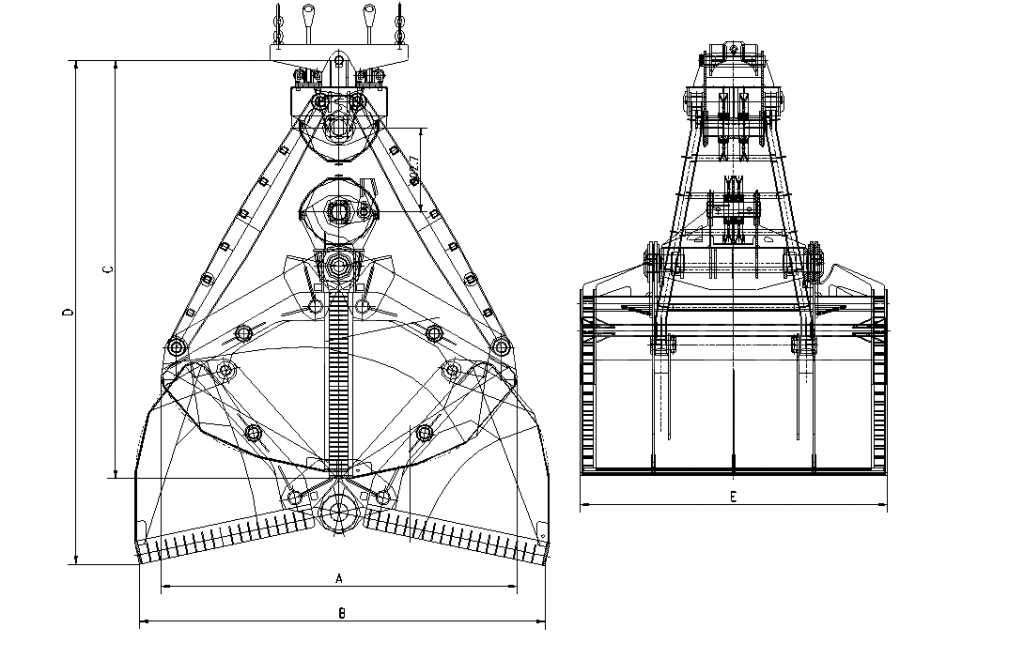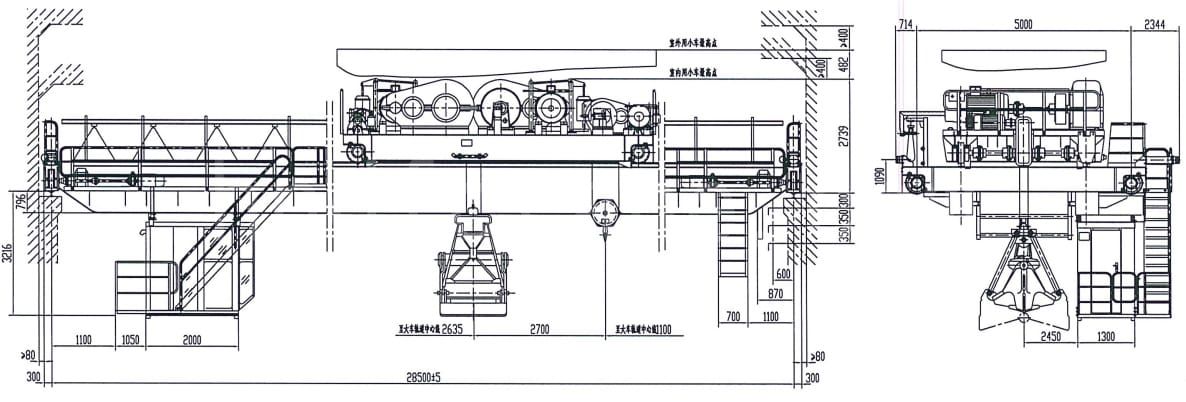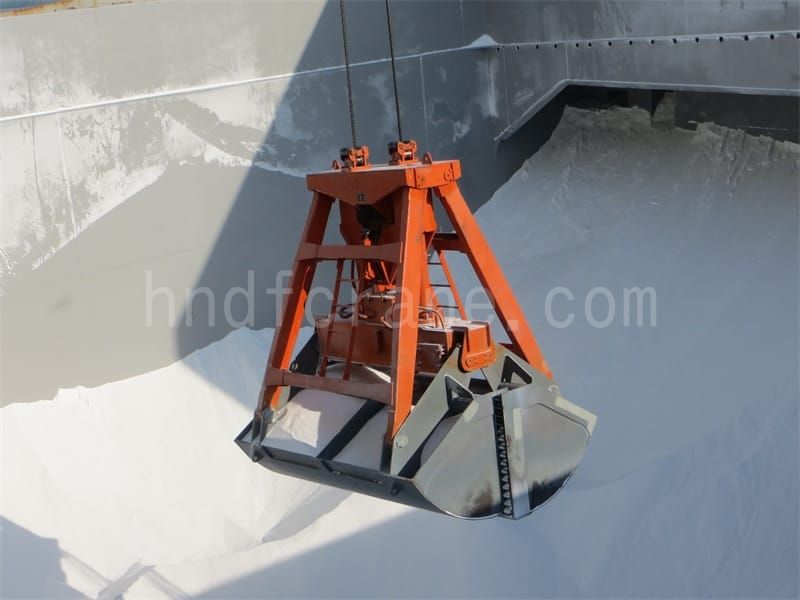Introdução do produto
A caçamba mecânica com garra tipo concha de quatro cabos é um tipo de operação adequada para portos, graneleiros, grandes depósitos de grãos e depósitos a granel.
Envolvido em materiais de transbordamento de partículas pequenas, é uma ferramenta ideal para o carregamento e descarregamento de materiais a granel que são fáceis de vazar, como grãos, fertilizantes a granel e areias minerais finas.
O balde mecânico com garra tipo concha de quatro cordas não vaza facilmente quando o material está cheio e funcionando.
A estrutura e o formato do balde de garras mecânicas tipo concha de quatro cordas são razoáveis, o aço é bom, a proporção entre o peso do material de preensão e o peso da garra atinge 1,5-1,92, e a plenitude atinge 95-100%.
Garra mecânica tipo concha de quatro cordas com capacidade de 95%~100%, é uma garra ideal para objetos soltos de grãos pequenos.
A estrutura da viga de apoio do balde com garras mecânicas de quatro cordas é encurtada, a resistência é boa e o peso é leve.
À prova de poeira e água, pode operar debaixo d'água.
A caçamba mecânica com garra tipo concha de quatro cabos é usada nas indústrias de grãos e mineração.
O balde mecânico com garra tipo concha de quatro cabos é mais propício para agarrar materiais dos cantos do vagão e da cabine.
As buchas principais são feitas de aço de rolamento, os materiais do eixo do pino são todos 40cr, rolamentos resistentes a altas temperaturas são usados nas polias e vedações de óleo de borracha de porta dupla são adicionadas. A borda é feita de aço estrutural de liga resistente ao desgaste como a placa de borda, que é fácil de soldar e reparar e tem boa resistência ao impacto.
Parâmetros técnicos

| Modelo | Volume (m³) | Densidade (t/m³) | Peso próprio (t) | Um (mm) | B (mm) | C (mm) | E (mm) | E (mm) | Diâmetro da polia (mm) | Altura de trabalho (m) | Diâmetro do fio de aço (mm) | Peso de elevação nominal (t) |
| CS10[3.3]4F | 3.3 | 1.75 | 4 | 2200 | 3064 | 3609 | 4111 | 1800 | Ø520 | 11 | Ø24 | 10 |
| CS10[5]4F | 5 | 1.2 | 4 | 2500 | 3313 | 3414 | 3903 | 2050 | Ø520 | 11.5 | Ø24 | 10 |
| CS10[7]4.4F | 7 | 0.75 | 4.4 | 2946 | 3762 | 3788 | 4417 | 2213 | Ø520 | 12 | Ø24 | 10 |
| CS16[5.5]6.2F | 5.5 | 1.75 | 6.2 | 2800 | 3480 | 4016 | 4582 | 2430 | Ø560 | 13.5 | Ø28 | 16 |
| CS16[7]6.3F | 7 | 1.2 | 6.3 | 2900 | 3830 | 3825 | 4468 | 2690 | Ø560 | 13 | Ø28 | 16 |
| CS16[12.5]6.5F | 12.5 | 0.75 | 6.5 | 3300 | 4144 | 4209 | 4936 | 2968 | Ø560 | 12.5 | Ø28 | 16 |
| CS20[7]7.5F | 7 | 1.75 | 7.5 | 3000 | 3092 | 4290 | 4872 | 2580 | Ø650 | 14.5 | Ø28 | 20 |
| CS20[15]8.8F | 15 | 0.75 | 8.8 | 3810 | 4340 | 4482 | 5398 | 3270 | Ø650 | 14.5 | Ø30 | 20 |
| CS25[9.3]9F | 9.3 | 1.75 | 9 | 3200 | 3951 | 4451 | 5031 | 3000 | Ø720 | 14 | Ø32 | 25 |
| CS25[12.5]9.8F | 12.5 | 1.2 | 9.8 | 3000 | 4321 | 4802 | 5786 | 3300 | Ø720 | 14.5 | Ø32 | 25 |
| CS25[18]10.5F | 18 | 0.75 | 10.5 | 4000 | 4760 | 4850 | 5807 | 3500 | Ø720 | 15 | Ø32 | 25 |
| CS30[22]12.5AF | 22 | 0.8 | 12.5 | 3953 | 4820 | 5162 | 5911 | 3600 | Ø920 | 15 | Ø36 | 30 |
| CS40[20.5]15AF | 20.5 | 1.2 | 15 | 4352 | 4945 | 5313 | 6387 | 3500 | Ø920 | 17 | Ø40 | 40 |
| CS40[32]18AF | 32 | 1 | 18 | 5000 | 5403 | 5991 | 7428 | 4100 | Ø920 | 17 | Ø40 | 40 |
| CS50[40]22.5AF | 40 | 0.6 | 22.5 | 5380 | 5819 | 6452 | 8000 | 4400 | Ø1020 | 18 | Ø46 | 40 |
Caso
Caso do projeto DAFANG CRANE - Garra mecânica é usada em pontes rolantes

- Tipo de garra: Garras mecânicas de quatro cordas, balde com garras de concha, volume de garra 4m3
- Gravidade específica do material: 2t/m3
- Tipo de projeto: Usado em empresas de materiais magnéticos de pó metálico, o cabo de aço adota o tipo de aço inoxidável resistente à temperatura.
- Referência de preço: A garra mecânica tem uma estrutura simples e custa cerca de 24.39% da garra hidráulica, o que a torna a melhor escolha se você tem um orçamento limitado.
Como escolher a garra certa
- Esclareça seu propósito:
Antes de se aprofundar nas opções, esclareça suas necessidades específicas. Pergunte a si mesmo:
- Com quais materiais você quer lidar? (Toras, sucata, pedra, etc.)
- Quais tarefas a garra executará? (Carregamento, classificação, desmontagem, etc.)
- A que tipo de dispositivo ele será conectado? (Ponte rolante, ponte rolante)
- Qual é a gravidade específica do material que você pega? O número de cubos da garra?
Qual é a tonelagem do seu guindaste equipado com uma garra?
De acordo com as características do material a ser agarrado, o agarrador é geralmente dividido em quatro tipos básicos: leve, médio, pesado e superpesado.
| O tipo de material a ser agarrado | Pegue o material | Capacidade de peso (t/m³) |
| Luz | Coque, escória, grãos, batatas, cal antracita de média qualidade, cimento, solo, cascalho, argila, tijolos quebrados, etc. | 0.5~1.2 |
| Médio | Turfa, grandes pedaços de carvão antracito, carvão compactado, argila, calcário, cascalho, sal, brita, tijolos, bauxita, flocos de óxido de ferro, cimento, areia e tijolos em água, etc. | 1.2~2.0 |
| Pesado | Calcário, argila pesada, minérios pequenos e médios, rocha dura, óxido de ferro em forma de barra, minério de ferro, pó de concentrado de chumbo, etc. | 2.0~2.6 |
| Sobrepeso | Minérios grandes, minério de manganês grande, pó de minério de chumbo aglomerado sedimentar, etc. | 2.6~3.3 |
- Compatibilidade de acessórios: Certifique-se de que o gancho seja compatível com o equipamento existente.
- Considerações orçamentárias: A faixa de preço do grab é diferente. Equilibre seu orçamento com base na função e durabilidade do grab.
- Comentários e sugestões: Pesquise online, leia avaliações de usuários e busque sugestões de colegas do setor.
- Vá até o fabricante do guindaste para inspeção e testes no local antes de comprar: teste o grab em condições reais o máximo possível. Avalie seu desempenho, facilidade de uso e funcionalidade geral.
Tenha em mente que escolher a garra certa requer um equilíbrio entre funcionalidade, segurança e custo. Ao considerar esses fatores, você encontrará a garra perfeita que pode aumentar a produtividade e garantir uma operação suave.






















































































